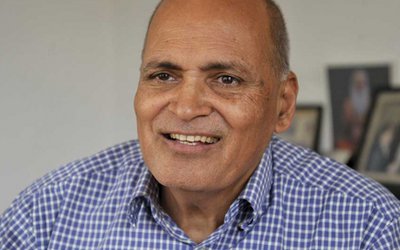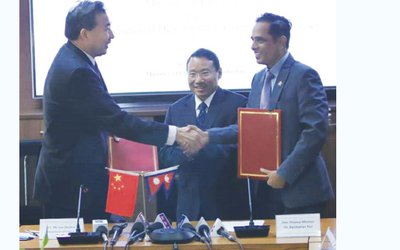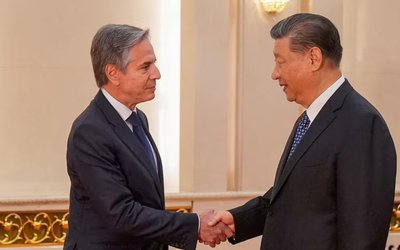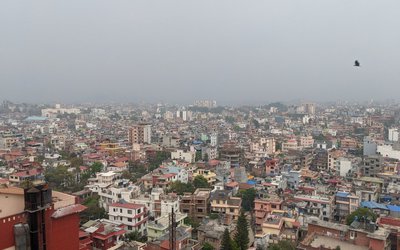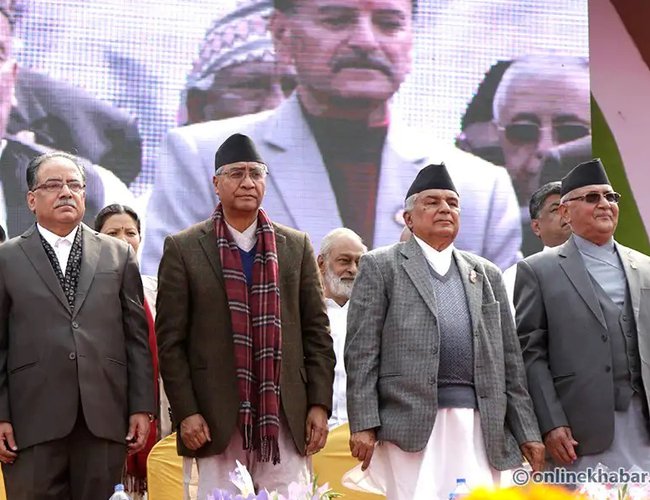
In the nearly two decades of Nepali democracy since the sidelining of the monarchy, doing away with the country’s Hindu identity and fracturing its governance with federalism – rebranded loktantra (peoples’ rule) from prajatantra (subjects’ rule) – corruption has become so pervasive, endemic and blatant that a more correct renamingcurrently describes it as loot-tantra. The last time I explored this topic in these pages was a year after the promulgation of the new 2015 constitution which falsely raised hopes that the country was finally on the right track towards good governance.
The new constitution with massive contradictions had finally come after a decade of dilly-dallying by main political parties (Kangress, UML, Noida Maoists) mouthing loktantra but looting state revenue even at the local level. This was done via “all party committees” that essentially trained lower rank cadres of main political parties and the bureaucracy in the fine art of rent-seeking and larceny. Its bringing forth hastily was precipitated by the devastating 2015 Gorkha earthquake when party leaders realized their unpopularity as they went to the villages to distribute relief. But it was followed by a crippling economic blockade by India displeased with some of its provisions, giving the hasty bad effort a veneer of nationalism.
Alas, it has taken hardly a half dozen years – and two parliamentary elections under this dispensation – to see all hopes of any decent governance dashed. These years have resembled a bad tele serial of unending scams and corruption at the highest level of parties and governments they lead. The blatant impunity with which they do so has been aided by a now discreditedcivil society, partisan academia of universities and a cabal of corporate sahuji media and their editors who carried them to power and were beneficiaries of what followed.
While they continue to sing peans of praise for this kleptocracy and its kleptocrats, the rot is visible to the helpless citizenry seething with anger. Its early indications were seen in the last local and national elections where young unknown faces managed to defeat well-known candidates of major parties. Its everyday indication can be seen at the Tribhuvan International Airport(TIA) with hordes of educated as well less educated youth voting with their feet against Nepal’s kleptocratic loktantra and heading to any pasture abroad that looks greener than the one at home. The situation is so dire, even engineering and management colleges previously highly aspired to are closing for lack of students.
Despite mainstream sahuji media’s cheerleading of kleptocracy (their publishers are mostly in cahoots with the kleptocrats in comfortably cosey crony capitalism alliance), what has come out of the malfeasance of its leaders now in powerful alternative and social media makes for breath-taking reading. Farsightnepalreports of “corruption and impunity institutionalized through a political mechanism that has a culture of collusion across political parties at large and a kleptocratic network of politicians and bureaucrats and even the private sector seeking private gains and institutional control”.
“They steal state revenues, capture development expenditure, engage in rent-seeking from the private sector and extract natural resources, milk wealth from citizens, control institutions, favour their kith and kins in lucrative dealings, and save the big fishes when things go south — all to amass wealth and consolidate power and use that to keep the corrupt mechanism intact. As all layers of state and non-state institutions are in bed for corruption, there is little room for accountability and justice.”
Onlinekhabar details eight major corruption cases of the last five years involving all major political leaders and prime ministers, and all shockingly all hushed up. The country’s flag-carrier Nepal Airlines saw its decline begin a quarter of a century ago with the Dhamija scandal under Girija Koirala and Chase Air scandal under the UML. The latest is an estimated Rs 4 billion corruption regarding its purchase of two wide-body aircrafts, in which investigations (subsequently hushed up) implicate former prime ministers Sher Bahadur Deuba and Khadga Prasad Oli. Another scandal is that of Lalita Niwas, official government land in a former Rana place that was embezzled into private ownership, and in which former prime ministers Baburam Bhattarai and Madhav Kumar Nepal were embroiled up to their gills. It was hushed, as publicly admitted by Kangress leader and former minister Minendra Rijal, to protect these two who are part of the current ruling coalition.
KP Oli’s majority rule saw the onset of Covid pandemic, which proved to be a bonanza for the prime minister’s crony capitalists such as Omni, Yeti etc. who were able to import equipment and supplies at inflated costs bypassing due procurement processes, and also acquire public lands (including in national parks) at throwaway prices. Even the parliament’s public accounts committees proved wholly ineffective in controlling the scams.
Oli’s other henchman Gokul Banskota was caught on tape soliciting Rs 700 million bribe in a deal to purchase printing press for the government. Maoist finance minister Janardhan Sharma let outsiders into the budget making process to alter tax rates to favour businesses close to the Maoists as well as to the son of former PM Deuba in the case of sanitary pad imports, undercutting Nepal’s small-scale women entrepreneurs who have made substantial progress on this front.
Gold smuggling through Nepal’s only international airport took to new heights under the current dispensation, so much so that wags have said TIA should be named Suvarnabhumi (gold land) instead of the one in Bangkok. (The serial “bikini” murderer Charles Shobhraj once said he could smuggle and elephant through TIA!) It involved hiding tens of kilograms of gold in motorcycle spare parts such as shoe brakes airlifted from Hong Kong, by Nepali and Chinese nationals AND senior Maoist ministers such as Barshaman Pun, Krishna Bahadur Mahara as well as their sons. Noida Maoist honcho and current prime minister is eager to hush these and other scandals up not only because he heads a government backed by corrupt ex-prime ministers complicit in many scams, but also because he fears exposure of his own scams involving embezzlement of Maoist fighter camp funds and justice finally catching up with him in killings of thousands of innocent Nepalis during the insurgency he led.
The Bhutanese refugee scandalinvolved selling refugee identity to Nepalis wishing to settle in the US and other countries. It has exposed another festering rot that implicates not just senior political figures of the current ideology-free coalition but also the wife of former PM Sher Bahadur Deuba, and in some ways UN’s refugee agency as well. That sacred national identity could be sold so blatantly by senior figures in Nepal’s Loktantrick government should also worry countries where such fake refugees have been resettled.
How useless was the Nepali parliament in putting a brake on the executive branch gone rogue has been highlighted by the last summer session of parliament. It lasted six months, passed only one major bill, spent about 430 million rupees, but had sittings only for 61 days of 255 hours, of which the opposition disrupted proceedings for 30 days. Some 69 days of the six months did not see any house sittings as leaders had gone on foreign visits, or had their own party meetings or because the government could not propose any legislative business. But the members of parliament – like their near useless members of the provincial assemblies and governments – continued to receive their perks and privileges even while doing nothing.
How did it get so bad? Corruption, like the “oldest profession”, has always existed, but in Nepal it has never been this pervasive and entrenched. Why? Anti-corruption agencies were made toothless by these very Loktantrick leaders when they did away with its mandate to investigate policy and high-level corruption. Commission for Investigation of Abuse of Authority (CIAA) for instance has no jurisdiction to look at policy decisions by the cabinet (which is where all the above high-profile corruptions originated); and the National Vigilance Center under the prime minister “is only empowered to take preventive and promotional measures against corruption”.
In a nutshell, the impunity with which the current dispensation indulges in corruption is rooted in a few fundamental “truths”. First, the same leaders who engaged in corruption since the mid-1990s are still in the top echelons of parties and governments despite three decades of scams and poor performance; and it is they who have suppressed each other’s’ scams in what is known as “bhagbanda” or divvying up the spoils of office. Second, we have designed a political system dependent on big money to run parties and win elections. And with legislators allowed to become executive ministers, they become bad legislators not interested in controlling the government but corrupt ministers themselves to recoup their election costs. Finally, by doing away with traditional religious values in the name of modernity and removing the institution of monarchy that was above competitive party politics, all brakes were off. Corruption will diminish only if this Loot-tantra is done away with.

Dipak Gyawali
Gyawali is Pragya (Academician) of the Nepal Academy of Science and Technology (NAST) and former minister of water resources.
- Maldevelopment And Technology: Ethos Harbingering Coming Apocalypse
- Apr 03, 2024
- World Social Forum: Rethinking and Redefining Development Itself
- Feb 21, 2024
- Remembering An Inspiring Karma Yogi
- Jan 09, 2024
- New World Disorder And The Case For Ideology
- Dec 13, 2023
- Will Nepal Leapfrog In Its Mobility?
- Sep 20, 2023






